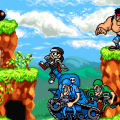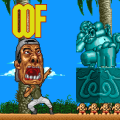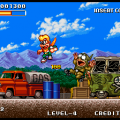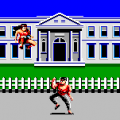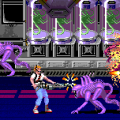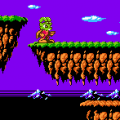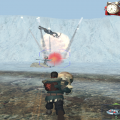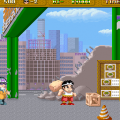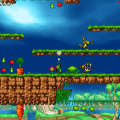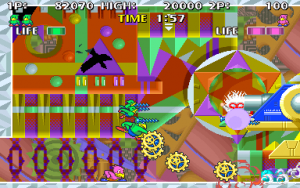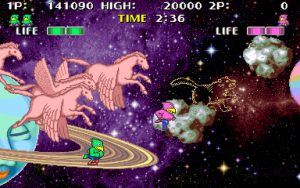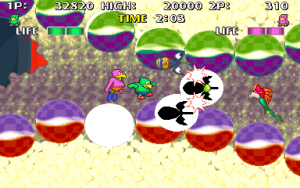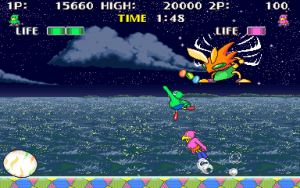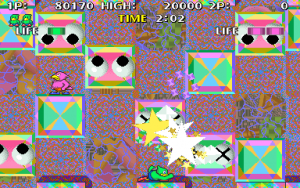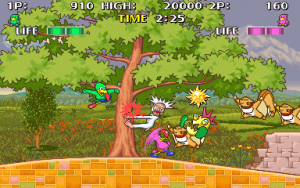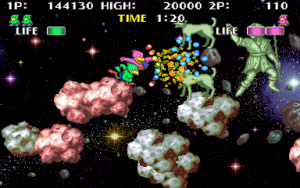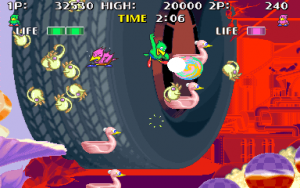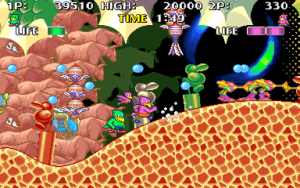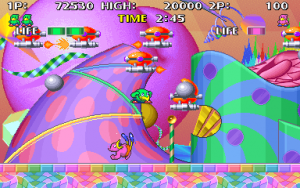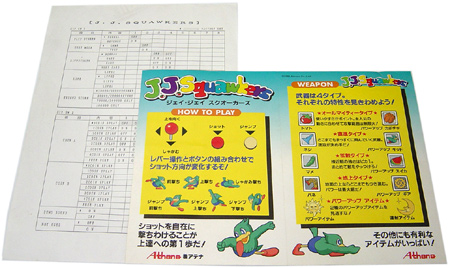
Japanese Arcade Manual
Athena is a company that fits the definition of “middle-in-the-line”. It was founded in July 1987, and stayed in the industry for more than two and a half decades, until eventually succumbing to bankruptcy around December 2013. Despite this, it’s not surprising you haven’t heard of their name, because their efforts were rarely great, even compared to the likes of Data East and Jaleco. Their single best title would be a make-your-shmup tool Dezaemon series, which single-handedly set gaming public on fire to send their samples, whose collection became huge enough to be bundled into standalone discs. Other notable works include things like Castle of Dragon and Super Bowling, and time proved they weren’t exactly classics. But they say a stopped clock can be right twice a day, and Athena released J. J. Squawkers for arcades in 1993, a somewhat respectable platformer that also happens to be so colorful and strange.
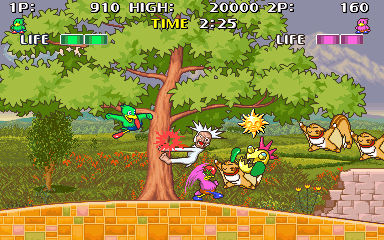
J. J. Squawkers (Arcade)
The game’s synopsis, told in the attract mode through extraordinarily funny Engrish, implies people fell into spells of some sort and went crazy. Right after putting in a coin, you see they ambush a house on tree and wreck it into pieces. It’s time for survivors, Ani Karasukun and Ototo Karasukun, to pay it back, and maybe find out the culprit behind this rampage. Although looking like parrots, they’re actually a pair of ravens according to their Japanese names.
J. J. Squawkers‘ first stage is a typical start for platformers, taking you through forest, village outskirts, and a short bridge, before it ends up with a fight against a giant insect. Even so, you’ll notice a few weird bits about it. Right in the beginning, there’s a guy in white Mickey Mouse suit, who does nothing but passionately humping to the tree. This stage also has a mid-boss, which is some sort of eldritch flower-chicken thing. There’s a way to get around if you pay attention to the surrounding, but nonetheless, the monster looks completely out of place next to other denizens.
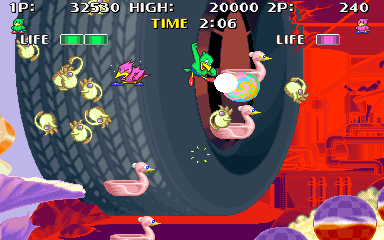
J. J. Squawkers (Arcade)
The subsequent levels get only more confusing from there. The second level takes place in nightmarish wonderland, composed of still life setpieces and some impressive artwork heavily inspired by Salvador Dalí paintings. The highlight of this stage is the stairs made of toy boxes, which wake up midway and proceed to toss you up to its boss fight. The third level is vaguely futuristic place, featuring loads of aggressive robots, perplexingly abstract landscapes, and absolutely garish color. At one point, it locks you into autoscroller where round-eyed blocks come together and try to crush you, making up for a very tricky platforming segment.
It becomes slightly less bewildering in the fourth stage, which has you run through cosmos where constellation occasionally comes to life and ambushes you, forcing you to care about not falling off meteorites. It does end up with a battle against ridiculously chirping three-headed dragon on a pirate ship, however. Sadly, after all these amazing spectacles, the last stage is a mere boss rush level that only contains a single room, a mopey conclusion to such a cheerful game.
All these wow-factors come together as a game that is stunningly attractive and well-paced, especially because of how incredibly detailed and well-directed the graphics are, only nitpick being some retina-unfriendly color choice. It’s a technical marvel, too, like the first level dynamically changing its brightness as the player advances, showing off the cycle between day and night. Karasukun brothers themselves are animated fluid and lively, and other enemies look unique and gorgeous as well. Conversely, the music is too muted to register any particular impression. When not, it’s annoying, notably the short, repetitive boss battle music that you’ll have to tolerate in the boss rush level.
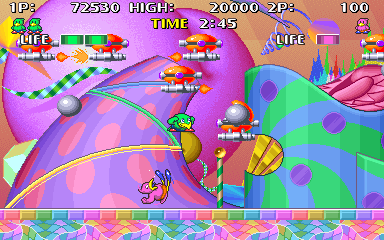
J. J. Squawkers (Arcade)
If you take out the prevailing craziness, J. J. Squawkers sticks to the usual platforming formula, which alone isn’t necessarily a bad thing. The game has unusual collection of weapons such as beans or pumpkins, all of which are generally powerful enough to defend yourself as long as you keep a power-up for it. On default setting, you can take two hits before it sends you back to checkpoints, but the game never gets too pressed for the most part. Most enemies take only one hit to defeat, and even bosses don’t put up much of a stressful fight, at least until you’ll have to beat them in a row in the last stage. The game does ramp up the challenge when you start the second playthrough, but it ends up being frustrating, because it simply speeds up the enemies to ridiculous extent.
When you get down to it, J. J. Squawkers is a strictly by-the-book arcade platformer that doesn’t try out something monumental or innovative, but it does decent job for what it is. It’s worth a look even if you’re not a fan of its trippy visual – the levels are well-designed, the controls are tight, and it isn’t particularly long or difficult. For those who don’t mind diving into MAME oddities, this can be a joyful ride from start to end. It may as well be considered one of Athena’s best, even though, as a game, it’s pretty average.

